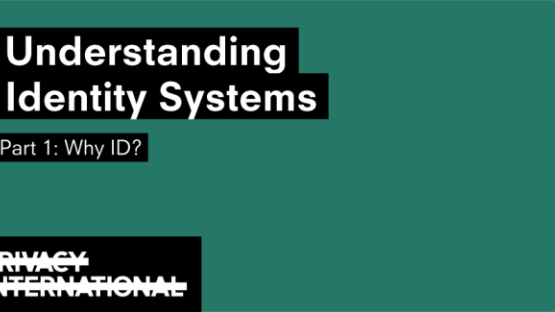Understanding Identity Systems Part 1: Why ID?

Introduction
Of all the data-intensive initiatives that a government can introduce, some of the largest are ID systems. They have implications across a broad range of human and civil rights. How do we begin to critique an ID system, to begin to understand its strengths and weaknesses? There are a series of issues that we believe should be addressed in the development of any ID system.
This could be of particular relevance to civil society organisations (CSOs): this is because civil society has a key role to play in the critique of identity systems. We have seen change, or even the abolition, of ID systems as results of the CSO engagement. Building on the experience of Privacy International over the past two decades, Understanding Identity Systems is designed to provide an overview of the issues surrounding the introduction of identity systems around the world.
The first section below, Why ID?, explores some of the themes around how and why ID schemes are introduced. The second section, Discrimination and Identity, explores how an ID scheme operates in the context of an existing identity infrastructure, and the issues surrounding discrimination that can emerge. The final section, The risks of ID, goes into more detail on some of the risks surrounding issues including biometrics and the breach of databases.
Part 1: Why ID? The motivations of introducing ID
The stated motivations behind an ID scheme
- There are many and varied reasons given by their proponents for the introduction or use of an ID scheme in a particular context. These include:
- Fraud prevention: to prevent identity fraud
- Security: to prevent attacks from foreign powers, terrorist attacks, and other national security threats.
- Crime-fighting or prevention: to reduce criminality
- Business: to facilitate the financial industry and other forms of industry
- Preventing trafficking: to prevent the trafficking of people either internally or externally
The need for evidence - the scale of the problem for ID to solve
- In order to justify the use of an ID system, there has to be evidence that the problem that it is designed to solve actually exists.
- For some cases, this justification must be clearly quantified. For example, if the argument is that an ID system will prevent benefits or social security fraud, this is a case where it would be expected that the cost of the fraud be clearly articulated. If there is not an existing idea of the scale of a problem, then it becomes impossible to judge whether a scheme is a success or failure. However, we see in practice that this quantification is not given, meaning that it is impossible to explore whether the claims made are justified.
The need for evidence - will ID solve that problem?
- Even if there is evidence for a problem, it doesn’t necessarily follow that an ID scheme will solve that problem.
- Again, quantification of the scale of a problem can sometimes be something that should be given by the proponents of a scheme. In the benefit fraud example, proponents often look to give a large headline figure for the scale of fraud. But how much of this fraud would be solved by the introduction of a scheme? The challenge is that ID would only be a tool to solve certain classifications of fraud – eg, impersonation fraud - which often make up only a fraction of the fraud that occurs.
- If figures, or evidence, are not available, then there is an onus to prove the effectiveness of the system that falls on the proponents.
- There also has to be ongoing auditing of systems and the impact of them upon populations, to ensure that the ID is solving the stated problem.
The proponents of ID need to express or quantify the negative aspects of ID
- Any analysis by the proponents of a scheme must include an analysis of the risks as well as the benefits of a scheme.
- The challenge of this is that the government pushing for ID often has an political interest in promoting the scheme, and thus getting accurate or non-partisan information can be difficult. This is one reason why an open, inclusive and meaningful consultation process is something that should be called for in the provision of any ID scheme.
- An ID scheme can often become closely linked to ideas surrounding nationalism, modernity and development: for example, the "Digital India" initiative. This becomes a challenge for those looking to critically engage with the programme, as it can leave them open to attack. It is essential that the environment is amenable to not only constructive debate about the provision of identity, but also questions as to whether a system should be deployed at all.
The alternatives to an ID system
- It may be that there are clear, sector-specific solutions that could provide an alternative to an ID scheme to solve these particular problems.
- Alternative tools can include:
- Other anti-fraud schemes may be more effective to establish the true causes of fraud. For example, in combating the provision of "ghost workers" - civil servants claiming multiple salaries, for instance - biometrics is cited as method for detection ghost workers, but in fact the truth may be different.
- The GSMA – the industry body for mobile phone networks – admits that there is no evidence that SIM-card registration has a benefit in combatting crime. See Privacy International’s explainer on this issue.
Other, less tangible, motivates for the introduction of an ID scheme
- In the context of an ID scheme, there are other motivations for its introduction that are less tangible, but are no less powerful. These may be explicitly expressed or not, and can be positive or negative in outlook.
- ‘Modernity’: the idea that ID systems are modern, and thus symbolic of a progressive movement.
- Nation-building: the use of ID to build a sense of belonging in the nation-state.
- Fear of the ‘other’: xenophobia, and fear of foreigners or immigrants, or another marginalised group.
- A tool for repression - for example, the use of voter ID requirements to repress the vote in certain communities.
The checks and balances of the legislative process
- Many ID systems are established by measures that bypass in some way the full legislative process. Sometimes, an ID card is introduced by presidential decree, without going through a legislative process.We also see other measures being deployed that limits the opportunity for scrutiny. We can also see universal ID cards being introduced 'by stealth', as an ID originally designed for one purpose gradually gets used for more and purposes.
- To give some examples, the SIBIOS biometric database in Argentina was introduced through a presidential decree. The NADRA biometric database in Pakistan was introduced while Pakistan was under military rule. The law establishing Aadhaar in India was passed as a money bill, limiting debate.
- ID projects are large, complex, and expensive enterprises, deserving of proper interrogation and debate. The same applies to future developments or changes to the ID system. It is also essential that ID schemes go through a process of an open, inclusive and meaningful consultation. This has to have sufficient time and resources, getting input from a variety of stakeholders.
Rights and data protection
- An ID scheme can have a breadth and scale that covers a huge amount of people's lives, and thus has consequences across the field of people's civil and human rights.
- Data protection laws seek to protect people's data by providing individuals with rights over their data, imposing rules on the way in which companies and governments use data, and establishing regulators to enforce the laws.
- Identity systems are a huge issue for data protection: they involve the collection and processing of vast amounts of personally-identifiable data. As such, a comprehensive data protection regime is essential to protect people. However, this is unfortunately in the context of many jurisdictions, public bodies are not subject to Data Protection law.
- Read more about data protection from Privacy International.
The right to change legal gender and name
- Trans people - who identify and present themselves in a way that differs from their formal ‘legal’ identity – face particular issues when it comes to identification. Having an identification document that does not match how they identify themselves leaves trans people open to the denial of services, and abuse.
- To learn more, listen to our podcast about the experiences of trans people in the Philippines.
- Thus, it’s important to explore what other laws exist surrounding the changing of an individual’s legal name and gender.
The cost of implementing an ID system
- Given the implications of ID systems for people's rights, the decision should be made purely on cost but if financial 'savings' of having an ID card, i.e. less fraud, is promoted then it should be included in the debate. Thus, the costs surrounding ID cards must be interrogated.
- The costs of an ID system can be massive. For example, the estimated cost of the Ghanaian biometric ID card - Ghana Card - is expected to cost USD$1.22 billion.
- A strategy to quantify the cost of an ID system can be an effective advocacy strategy in opposing a scheme. For example, in the UK, the proposed ID scheme in the 2000s was estimated by the government to cost £5.5 billion. However, a detailed study by the London School of Economics found that the true cost was likely to be significantly higher - at between £10 billion and £19 billion. This, in combination with a discourse after the financial crash about cutting government costs, was one of the issues that helped to defeat the scheme.
"Voluntary" ID
- Sometimes an ID card can be described as “voluntary”. But what does that mean?
- Is it mandatory for some service? For example, is it mandatory to have a card to claim certain benefits? In which case, it is not “voluntary” for recipients of these benefits. This means that members of certain groups can be forced to get an ID, or risk denial of benefits.
- It also matters what the actual lived experience of people is, and the reality that they experience of whether ID is mandatory or not can differ greatly from the legal context. An ID system can become ubiquitous in society, particularly as it is linked to more and more aspects of people's lives.
- All of this risks the consequence of excluding some from vital services to which they entitled. For more on privacy and exclusion, read Privacy International's research.
Continue to Part 2: Discrimination and Identity, or skip to Part 3: The risks of ID.



